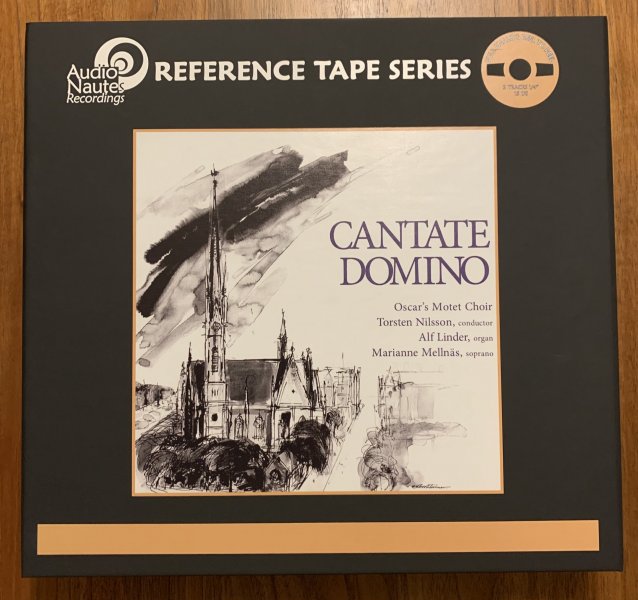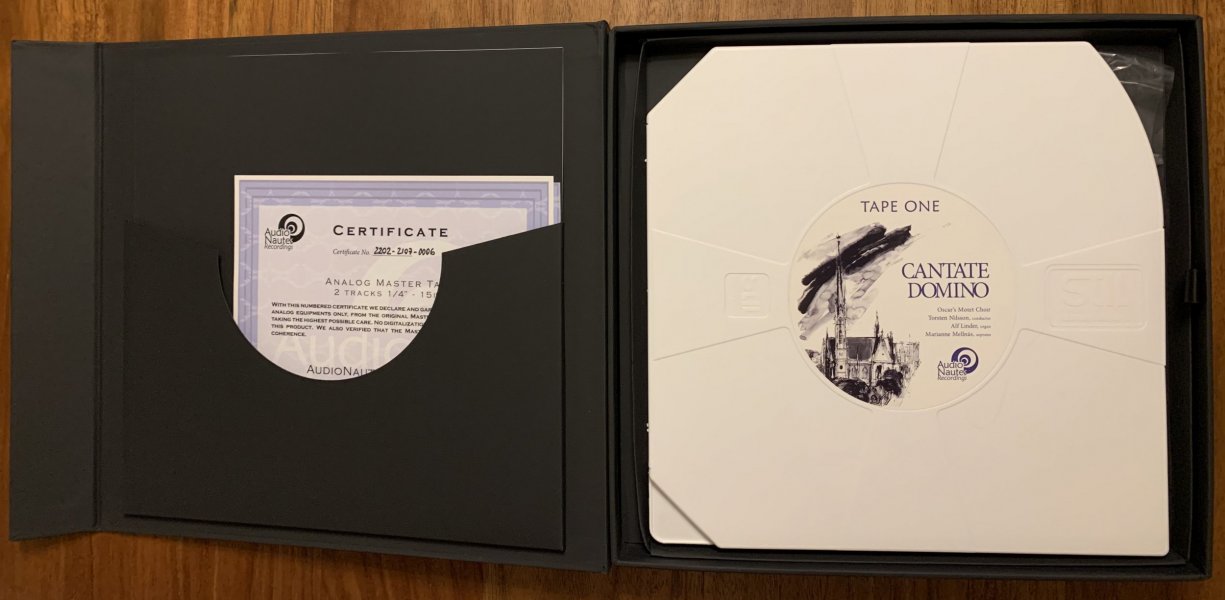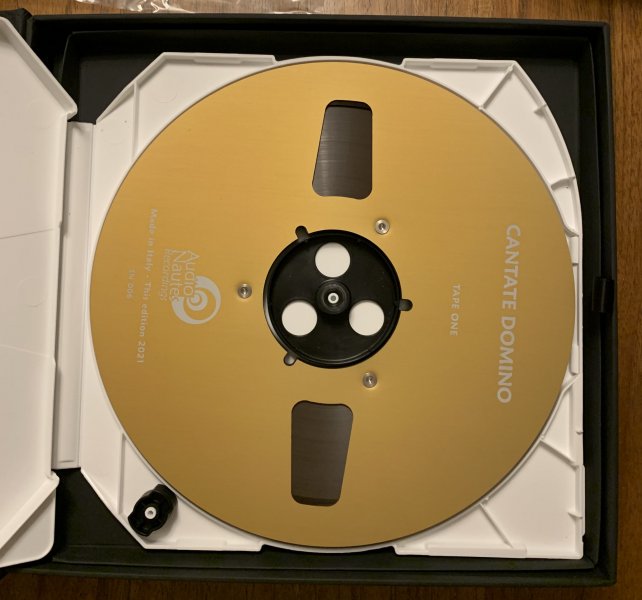I just received the Cantate Domino tapes today. I listened to them right away after work tonight. The packaging is the best I have seen. There is the full 2500 feet of tape in each reel, which is good and bad. This makes it easier to secure the tail of the tape, but it means more winding and rewinding. There is leader tape on both the tail and the head of the tape, which is good. There is also a certificate of authenticity, and another piece of card detailing the technical information. My copy is no. 006.
I played the tape on my Nagra T Audio, with the playback head wired directly to my tube tape head preamp. I built this as a phono preamp 20 years ago, and later modified it for tape head duty. It is a fully balanced differential design, with a FET/Tube cascode phono section with passive EQ, and a two stage line section. It has a shunt regulator for the B+, and there is no feedback. This preamp is built with point to point wiring, whereas I have the identical design built on PCBs serving as my phono preamp. This makes direct comparison with the LP easier.
This tape has the best sound I can remember ever hearing from this recording. The whole performance is distortion-free, with excellent ambiance. One can hear the natural decay of the sound all the way down to the very low noise floor. The recording venue has a very long reverberation time, but not so long that the sound loses clarity. The image is rock solid, with a very natural presentation of the choir and the soloists. The only word that I can use to describe the whole experience is realistic. I find that good recordings on analog master tapes sound closest to the live experience, since it has the scale and the dynamics of live music, but without the artifacts that one often finds in digital recordings. It is the continuity, the weight and the density of the sound that make tape recordings so special. This tape has all these qualities.
I tried to find my original copy of the LP that I bought as a student almost 40 years ago, but no luck. I remember the record being pretty noisy, since I did not have very good equipment in those days. I do have the later ATR mastercut LP. Even though I have not played this LP much (since I had already been overdosed when this was THE demo recording during much of the 1980s), the surface noise is a bit annoying even after cleaning with the Degritter machine. Worse, I noticed the sibilance of the soloists right away. There is also audible distortion during the louder high notes. Even though my record player is not exactly high end (Classic Turntable Company Garrard 301, SME 3012 S2 with metal knife bearing, Ikeda headshell and 9TT cartridge), I have not heard distortion to this degree on even more demanding recordings. This makes the voices sound less natural, and the choir sounds less well balanced. As I do not have another copy of the LP, I can't say whether this is due to the mastering or the pressing. When one buys an LP, one never knows whether it came fresh from an early stamper that came from an early mother, or from a worn late stamper from a late mother. It is really a crap shoot. I have almost 300 titles on tape, almost all copied from production or safety masters, or from commercial sources such as this tape. I must say that I have yet to hear an LP, reissued or original pressing, that is better than the tape. Of all the expensive upgrades one can make nowadays to one's system, few can be as cost effective as investing in tapes of your favorite recordings. I have not invested much into digital playback, and I really only use it to explore music I am not familiar with. The money I have saved (at least in my mind) justified my investment in tapes. I find the experience of listening to tapes unique and not replicable with other sources. This alone makes the investment in time, effort and money worthwhile.



I played the tape on my Nagra T Audio, with the playback head wired directly to my tube tape head preamp. I built this as a phono preamp 20 years ago, and later modified it for tape head duty. It is a fully balanced differential design, with a FET/Tube cascode phono section with passive EQ, and a two stage line section. It has a shunt regulator for the B+, and there is no feedback. This preamp is built with point to point wiring, whereas I have the identical design built on PCBs serving as my phono preamp. This makes direct comparison with the LP easier.
This tape has the best sound I can remember ever hearing from this recording. The whole performance is distortion-free, with excellent ambiance. One can hear the natural decay of the sound all the way down to the very low noise floor. The recording venue has a very long reverberation time, but not so long that the sound loses clarity. The image is rock solid, with a very natural presentation of the choir and the soloists. The only word that I can use to describe the whole experience is realistic. I find that good recordings on analog master tapes sound closest to the live experience, since it has the scale and the dynamics of live music, but without the artifacts that one often finds in digital recordings. It is the continuity, the weight and the density of the sound that make tape recordings so special. This tape has all these qualities.
I tried to find my original copy of the LP that I bought as a student almost 40 years ago, but no luck. I remember the record being pretty noisy, since I did not have very good equipment in those days. I do have the later ATR mastercut LP. Even though I have not played this LP much (since I had already been overdosed when this was THE demo recording during much of the 1980s), the surface noise is a bit annoying even after cleaning with the Degritter machine. Worse, I noticed the sibilance of the soloists right away. There is also audible distortion during the louder high notes. Even though my record player is not exactly high end (Classic Turntable Company Garrard 301, SME 3012 S2 with metal knife bearing, Ikeda headshell and 9TT cartridge), I have not heard distortion to this degree on even more demanding recordings. This makes the voices sound less natural, and the choir sounds less well balanced. As I do not have another copy of the LP, I can't say whether this is due to the mastering or the pressing. When one buys an LP, one never knows whether it came fresh from an early stamper that came from an early mother, or from a worn late stamper from a late mother. It is really a crap shoot. I have almost 300 titles on tape, almost all copied from production or safety masters, or from commercial sources such as this tape. I must say that I have yet to hear an LP, reissued or original pressing, that is better than the tape. Of all the expensive upgrades one can make nowadays to one's system, few can be as cost effective as investing in tapes of your favorite recordings. I have not invested much into digital playback, and I really only use it to explore music I am not familiar with. The money I have saved (at least in my mind) justified my investment in tapes. I find the experience of listening to tapes unique and not replicable with other sources. This alone makes the investment in time, effort and money worthwhile.




